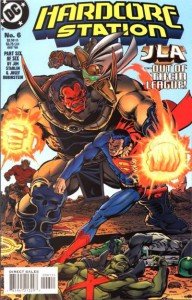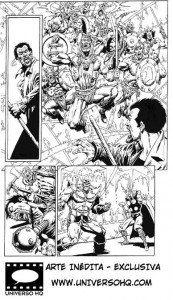
Jim Starlin: A success written in the stars
Universo HQ had an EXCLUSIVE interview with Jim Starlin, creator of Dreadstar and managed to obtain worldwide never seen before art of his new work for Marvel
 Men were always fascinated by the vastness of the cosmos. Many have used it as a main theme in every form of art. In comics. There is one artist that did and is still doing many incursions into the stars and his name is Jim Starlin.
Men were always fascinated by the vastness of the cosmos. Many have used it as a main theme in every form of art. In comics. There is one artist that did and is still doing many incursions into the stars and his name is Jim Starlin.
Creator of Dreadstar, Starlin has an impressive résumé. He was the first comic artist to “really” kill a super-hero, Captain Marvel. He also plotted the death of Jason Todd, the second Robin. The mega villain Thanos is his creation. He worked with some heavyweight characters like Superman, Batman, Silver Surfer, Hulk, Iron Man, Aquaman and others.
Recently he did the drawings on a few issues of the new Captain Marvel and is currently involved in a series of projects, like reprinting the complete Dreadstar in black and white trade paperback volumes, for Slave Labor Graphics. For the fans of the Cosmic Warrior a surprise: Starlin says he wants to go back to him and he will probably kill him!
Jim Starlin gave an interview to Universo HQ, and spoke about his career, his work at the major publishers, favorite characters and future work. And it doesn’t stop there: You will see, BEFORE ANYONE ELSE IN THE WORLD, unpublished pages of his new work for Marvel. Yes, you read correctly! These images are totally new and never seen before!
So prepare yourselves, your intergalactic journey is just beginning!
Universo HQ: What is your academic and artistic formation?
Jim Starlin: Very little academic training. Mostly just drawing in my room as a kid, looking at comics and trying to figure out how to draw them.
UHQ: How old are you and when did you start working with comics? What made you to want to work in the field?
Starlin: I’m 51 and have been working in comics professionally since 1972. I’ve always loved comics and wanted to write and draw them since I was 8 years old.
UHQ: A lot of people say that Jack Kirby was a big influence in your work. Is this true? What artist did influence your style? Who were your idols then?
Starlin: Kirby was my god with Steve Ditko running a close second. Other childhood influences were Gil Kane, Carmine Infantino and Joe Kubert.
UHQ: What are the differences between working for Marvel and DC Comics? Which companies’ characters do you prefer to work with?
Starlin: Most of the time the differences are very little. It all depends on who’s running the show up at any given time and which editor you’re working with. When I worked with Kevin Dooley on “Hardcore Station” it was a nightmare. But I worked with Archie Goodwin on another project up there and it was marvelous. I’m now working with Tom Brevoort up at Marvel and am having a great time, he’s very professional and friendly. Other Marvel editors I haven’t been so lucky with.
I do have a warm spot in my heart for Superman and Batman because I grew up with them but I’m currently working on my favorite characters up at Marvel. It changes with who’s in charge at either company. Right now I like the folks working at Marvel and am working for them. That might change next year. Who knows.
UHQ: You’ve drawn some of the first stories of Master of Kung Fu, although not too many people recall that, a character that marked many readers. What was your relation with the character? Was that a special moment in your career?
Starlin: Working with Steve Englehart was fun and I loved the TV show Kung Fu. We wanted to do a comic adaptation of the show but Time Warner owned the show so. The bad thing about that project was having Fu Manchu added to the mix.
I had never read any of them and had no idea how racist the books were. Many of my Asian friends gave me an earful after the book came out.
UHQ: What were the differences of working with Marvel back in the days when you drawnAdam Warlock and The Avengers (The Thanos saga), and the later period when you did the mini-series Infinity Gauntlet and Thanos Quest?
Starlin: The longer I work for Marvel the slower they are about okaying projects. When I did Warlock I talked to Roy Thomas in the afternoon and was drawing the first page that night. Now I’ve been waiting three months for them to give a green light on the Infinity Abyss.
UHQ: You used The Death of Captain Marvel as a way to express your feelings in relation to your father’s death. How it was to do this project? What was the fans response to the story? After all, you killed a beloved hero!
Starlin: It was a cheap form of therapy. Loved doing the project and most fans liked it also. Did get a few death threats. No big deal. Got more grief from a number of my fellow professionals who were annoyed that I got the first U.S. deal with royalties.
UHQ: Is it true that, at the time, you did that Graphic Novel for Marvel so that in return they would publish Dreadstar on the Epic label?
Starlin: Yes, Shooter and I cut a deal about starting a creator owned line if I did this project first.
UHQ: Do you still know what happens in the Marvel Universe and the characters that brought you fame, like Adam Warlock, Avengers and others? What do you think of the new monthly Captain Marvel comic, that’s been written by Peter David? How is your relationship with him, since he also worked on Dreadstar?
Starlin: Fine. I’ve actually drawn three issues of the new Cap for Peter (11, 17 & 18). As for the other characters I’ll be using Thanos, Cap Marvel, Warlock, Moondragon, Gamora, Dr. Strange, Spiderman and Pip in the Infinity Abyss, a six issue miniseries I’m writing and drawing for Marvel.
UHQ: What originated the Metamorphosis Odyssey, on Epic Illustrated, the story that ultimately became the Dreadstar comic. Did you have that in mind from the beginning?
Starlin: No, originally the idea was to do a close ended fairy tale kind of story. But I warmed up to Dreadstar along the way and other stories came to life on their own. Plus Marvel suddenly saw the advantage of doing creator owned characters. That’s how the Epic line of comics got started.
UHQ: Tell us about your work on the mini-series Batman: The Cult. This was one of the first important books with the character since Dark Knight Returns and some comparisons were inevitable. How did you dealt with that?
Starlin: Actually I don’t remember anyone comparing the two stories. I was gearing my Batman off Miller’s because it was the best one going at the time. If it should be compared to any Miller job I’d think it would be Ronin. Both stories take place a good deal in sewers.
UHQ: What was the repercussion of Robin’s death? Is it true that American readers hated Jason Todd? And how was the public voting to decide Robin’s fate? Do you believe that Robin still have a place in the current Batman universe?
Starlin: Yes, everyone hated Jason Todd. I wanted to kill off Robin as soon as I started writing Batman. The idea of taking a kid along to fight crime is ludicrous. Then Denny O’Neil came up with the phone call-in deal. He immediately started taking complete credit for the idea of killing off Robin.
Then the book came out and the executives up at Time Warner realized they had all these lunch boxes and sheets with robin on them and suddenly it was completely my fault for killing off Robin. Within three months I was gone.
UHQ: Why Dreadstar was released by the Epic label? After moving to First Comics, what brought it’s end? In Brazil today, we still have hordes of fans self-titled “orphans of Dreadstar” that doesn’t know the end of the story, since it was never completely published here!
Starlin: I’m working on getting the entire Dreadstar series published through Slave Labor Graphics. Epic was the creator owned line of comics up at Marvel. When Marvel and I had a falling out over moneys owed I took it to first and later to Malibu Comics.
UHQ: With Dreadstar you were one of the pioneers of the creator’s rights in American comic industry. And yet, you never published anything else with the character, and after so many years when he returned it was given to another creative team. Have you lost the interest in working with Dreadstar?
Starlin: I wrote, penciled and inked probably the equal to fifty issues of Dreadstar. I needed a break and just haven’t found the situation lately where I could make any money doing new Dreadstar stories. It is a business.
UHQ: How are the sales of Slave Labor’s reprint of Dreadstar?
Starlin: Good enough to continue publishing. There will be a break of about six months between books four and five while I work on the Infinity Abyss.
UHQ: Every good story should have a start, middle and an ending. Do you plan to really end the Dreadstar series? What future plans do you have for the character?
Starlin: Someday, somewhere I will return to Dreadstar and eventually kill him off at the end of the run. I also have a story I want to do with Dreadstar called Class Warfare.
UHQ: How did Bravura Comics, where you published Breed I and II, started? What was your participation in it? In your opinion why did the label ended?
Starlin: Harris Miller, my lawyer and the lawyer of most folks involved in the Bravura line, set up a creator owned deal with Malibu Comics. Chaykin came up with the name. In the end the line died because the Malibu business folks weren’t very good at their job and Marvel ended up buying the company.
UHQ: You were one of the first writers to really “kill” important characters. Nowadays death and resurrection are a common happening, almost always in a desperate attempt to elevate sales. What do your think of it?
Starlin: Very little.
UHQ: In the great majority of your stories we have action happening in outer space, other planets or even other universes. Is there any special reason for that fascination with the cosmos?
Starlin: Yes, I hate drawing cars and people in suits. Plus you can do more real or relevant stories if you disguise them as fantasy. Using this method I’ve done tales on everything from incest to bashing big business when I couldn’t have pulled it off if I set them in the “real world”.
UHQ: Do you still read any comics? Who are your favorite artists today?
Starlin: Very few. Anything by Moore and Miller and a few marvel connected to what work I’m doing. I also enjoy Peter David’s stories.
UHQ: You worked with Superman, Batman, Aquaman, Silver Surfer, Hulk, Iron Man, among other successful characters! Is there any super-hero character that you wanted to work with but didn’t manage to do it?
Starlin: Millie the Model. No, really I’ve done pretty much most of the characters I ever wanted to.
UHQ: Who is your favorite character?
Starlin: Thanos. I created him and every time I come back to Marvel he’s sitting there waiting for me to play with him no matter what title I’m working on.
UHQ: You have been working with comics for more than 30 years. What attracts you so much on this medium? What do you think of the current troubled phase of comics?
Starlin: It will eventually pass. Maybe now with Bush as president. Whenever we’ve had a republican President and the general economy has taken a nosedive, the comic book industry has prospered. Just look back at its best years; during the Nixon term and the Reagan/Bush years. We do best when everyone else are hurting.
UHQ: You offered Marvel a series called Infinity Abyss, what is it about and how are the negotiations proceeding?
Starlin: Green lighted and it’s about reality falling into the abyss. More later.
UHQ: After so many years, Marvel Comics decided to “resurrect” Rom, the space knight, in a 5 issues mini-series, with your argument and drawings by Chris Batista. Did you liked working with the character?
Starlin: Not really. I thought he was a pretty dumb character back in the seventies. I just took on the job of scripting the series so that I could pay for some parts for my boat. I was strictly a hired gun on that project. I won’t be doing any more of them.
UHQ: Tell us about Wyrd: The Reluctant Warrior, this material is unknown to the Brazilian public.
Starlin: Wyrd is a humorous, big-foot, political comic about big-buck vs. magic and inadvertent homosexuality. It’s one of my favorite jobs and it’s a pity so few people have seen it. It’s available in a collected version through Slave Labor Graphics.
UHQ: Could you give us more details about your other activities like writing books and software?
Starlin: I co-wrote four novels with Daina Graziunas, my ex-wife, (Among Madmen, Lady El, Thinning the Predators and Pawns, which was serialized in the back of Dreadstar. I co-own a computer company called Electric Prism which does everything from designing web sites to adapting architectural drawings to construction plans. My actual involvement in the company is minimal these days.
UHQ: Do you believe in the Internet potential for comic books? Do you think it will replace paper? What do your think of the current news about Stan Lee Media?
Starlin: Stan Lee Media laid off most of its staff a week or so back. I don’t think you’re going to find a substitute for the pleasure of holding an actual comic in your hands any time soon. Ever try reading an internet comic while you go to the bathroom?
UHQ: Would you send a message to your Brazilian fans?
Starlin: Keep reading and believing. Life’s too short not to have fantasies.
UHQ: Starlin, thank you very much. Success, always!
Starlin: Thank you.


















